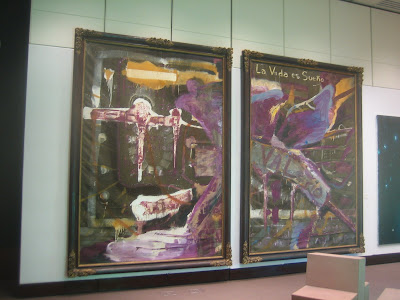
Seriously. Auction previews are awesome. Phillips Saturday. Christie's Sunday. Plenty of killer art to be seen as it floats between collectors. PLUS, it's fun to laugh at the rich. Although the auctions can sometimes hurt. Some woman poured her aching heart out to me on the stairs because of an if-only moment she had just experienced with a Jules de Balincourt that was up for auction that she could have had for a song back in the day. What a drag. And what made it worse was that she really seemed to like the piece. I have a feeling that she was more upset that it wasn't on her wall than the fact that she could have resold it for 4 gazillion dollars. She totally got my Cool Award for the day.
Banksy, trapped in a John McCracken . . .

Worst Schnabel EVER. Make it stop, Poppa. Doesn't this look like something that Dusty would buy?

Overheard 5-year-old kid critique of the day: "It needs a spider." Heh-heh. Too cute. I'm sure Jim Hodges will get right on that.


2 comments:
re: "Worst Schnabel EVER. Make it stop, Poppa."
I don't know. Seems like a cool painting, but then again, I generally like Schnabel's paintings.
regardless of what I think about Schnabel's work, what you wrote is very funny.
More Schnabel humor:
Phillips de Pury & Company auction entry for said artist...
"JULIAN SCHNABEL
Despite all of the gravity and emotion of these works, and despite the artist’s boundless energy, one ultimately discovers a component that may come as a surprise to many: the lighthearted humor that sparkles both in Schnabel and his art. The humor is evident even in the Plate Paintings, specifically in the selection of materials. Actually, these plain plates, some of which still bear the price label, are meaningful only in a historical sense, as they are broken and have already experienced history. As fragments, they take on a new value and potential for meaning they could never have attained as simple, unaltered plates on canvas. We respond to these fragments of a commonplace product with an entirely new set of expectations and immediately begin to look for the inherent historical quality, the act that preceded their final existence as shards. In our longing for history and meaning, we project precisely such values onto the object. Schnabel’s selection of this particular object of our private everyday culture, which essentially has no identity, for a special destiny of meaning is a gesture which, despite the earnestness of his approach to content in all of his works, also betrays a playful attitude towards his surroundings even in his earliest paintings.M. Hollein, “TheWorks and theirViewers,” Julian Schnabel, Paintings, 1978-2003, Madrid, 2004, p. 40Julian Schnabel’s prolific and creative drive to reintroduce new materials onto the canvas surface was a harbinger of stylistic innovations to come into maturity at the end of the century. Artistic mediums carry an increasing amount of cultural and conceptual meaning in today’s art techniques, similar to the way that subject matter and iconography once did in medieval religious painting. Inspired by the mosaic technique of the Spanish artist Gaudi, Schnabel pursued the technique and iconography that was inherent to traditional Spanish architecture. Schnabel’s plate paintings introduce a new approach to the way the artist and the viewer communicate by breaking down the line and introducing new planes upon which the images are forced to undulate over, broken and distorted, across the surface mosaic.This approach to painting represents a complex philosophical approach to art historical modes of thought. Tomorrow I Shave depicts a wise man, with a long traditional beard, whose conservative demeanor is betrayed by a philosophical introspection. Schnabel’s fascination with religious iconography is pummeled into the modern world, where religion is questioned and carelessly dismissed for material pleasures."
http://phillipsdepury.com/auctions/lot-detail.aspx?sn=NY010208&lotnum=141&search=&p=4&order=#
Post a Comment